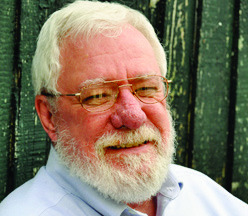The town of Scott has long claimed to be “where the West begins” because timetables listed it as the “origin of western travel” on the railroad that eventually became the Southern Pacific. But in 1933, when the U.S. Geological Survey published a “Guidebook of the Western United States,” it appeared that “the West” began far to the east, at the Mississippi River.
The guide traces the route along interconnected railroads from New Orleans to Los Angeles with a paragraph or two about each stop along the way. It gives us a glimpse of life in south Louisiana in the 1930s and offers a fair account of how our landscape changes from swamps to bayous to prairies as the train chugs west.
“The line from Algiers to Lafayette now known as Morgan’s Louisiana & Texas Railroad & Steamship Co. was incorporated in 1852 as the New Orleans, Opelousas & Great Western Railroad Co. It reached Morgan City … in 1857 and Lafayette in 1880,” we learn. “It was operated by the United States during the Civil War and owned by Charles Morgan from 1870 to 1878. The Louisiana & Western Railroad Co. was built from Lafayette to the Sabine River in 1881, and the Texas & New Orleans Railroad Co. was constructed from Orange [Texas] to [the] Sabine River (at Echo) in 187881.”

Bradshaw
Bradshaw
The first stop heading west from Algiers, across the Mississippi from New Orleans, was Donner, 65 miles from the river, a community that impressed the USGS mostly because it was in the middle of a swamp where all but the ridge that carried the tracks flooded frequently. Gibson, two miles down the line, was little better. It had a population of only 60 people, and “a quaint old church” was about the only thing worth seeing, according to the guide.
At 80 miles the trains reached “the old settlement of Boeuf,” from which the rails followed the north bank of Bayou Boeuf for half a mile to Morgan City. There, the USGS said, the town’s 5,085 people were “principally occupied in agriculture, shipping crabs, and preparing shells for chicken feed and other uses.” Berwick, just across a long railroad bridge, was “a companion town … sharing with it the river trade and crab industry.”
Patterson, 88 miles west of the Mississippi, was regarded as “the beginning of the lower Atchafalaya River” that met thereabouts “the famous Bayou Teche.” From there, the rails followed the Teche through Franklin (102 miles), Baldwin (106 miles), Jeanerette (115 miles), and New Iberia (127 miles), a scenic route along which travelers viewed “many fine houses, luxuriant gardens, and handsome live oaks and pecan trees.”
At Cade (134 miles), a branch line went to St, Martinville, “a most interesting place,” where travelers could visit Evangeline’s grave under the Evangeline oak, and where “souvenirs of her life are on exhibition.”
At Broussard (140 miles), the train left the Evangeline country and moved into the Attakapas region. Lafayette (146 miles) was a growing railroad center, where the first locomotive used on the Morgan Line could be seen from the passing train. (It was displayed at the depot until, amid much tooth-gnashing, it was reduced to scrap metal in the 1940s to help win World War II.
Insult of all insults, the guidebook about rail travel to the West does not even mention Scott “where it begins,” skipping from Lafayette to Rayne (160 miles) and Crowley (168 miles), centers of the rice industry, as were Estherwood (171 miles), Midland (176 miles), Mermentau (182 miles), and the “pretty town” of Jennings (186 miles), which was then famous for “the extensive cultivation of Bermuda or Easter lilies, which are shipped … all over the United States.”
At Welsh (197 miles) the rails that had meandered along riverbanks and bayou ridges now turned due west across a flat prairie to head for Lake Charles (220 miles) and its inland port, which shipped more rice than any other in the country. A large mill near the port made cellulose from rice hulls and was “said to be the only plant of its kind in the world.”
Sulphur (230 miles) was duly recognized for the nearby mines that once dominated the world sulphur industry. Oil derricks dotted the landscape just south of Edgerly (238 miles). From Vinton (243 miles), the railroad followed a little ridge to Toomey (245 miles) before crossing the Sabine into Texas and making a great curve to the south toward Galveston.
You can contact Jim Bradshaw at [email protected] or P.O. Box 1121, Washington LA 70589.

